Analysis of Damage and Permeability Evolution of Sandstone under Compression Deformation
Abstract
:1. Introduction
2. Coupling Analysis of Rock Damage and Permeability
2.1. Coupling Mechanism
2.2. Damage and Deformation
2.3. Permeability and Deformation
2.4. Coupling Equation
3. Numerical Implementation of Damage–Permeability Model
- (1)
- First, a constitutive model that can well describe the damage evolution and deformation characteristics of rock was proposed and implemented numerically.
- (2)
- Second, the deformation and damage parameters in the stress field were implemented in the seepage field to induce the fluid flow.
- (3)
- Third, the effective stress and pore pressure in the seepage field were implemented in the stress field for influencing the rock deformation.
- (4)
- Finally, the last iteration was repeated until the end.
4. Model Validation and Results Analysis
4.1. Fluid–Solid Coupling Analysis Model
4.2. Damage Evolution Analysis
4.3. Permeability Evolution Analysis
5. Discussion
6. Conclusions
Author Contributions
Funding
Institutional Review Board Statement
Informed Consent Statement
Data Availability Statement
Conflicts of Interest
References
- Bérest, P. Cases, causes and classifications of craters above salt caverns. Int. J. Rock Mech. Min. Sci. Géoméch. Abstr. 2017, 100, 318–329. [Google Scholar]
- Chen, X.; Wang, J. Stability analysis for compressed air energy storage cavern with initial excavation damage zone in an abandoned mining tunnel. J. Energy Storage 2021, 45, 103725. [Google Scholar] [CrossRef]
- He, M.; Sui, Q.; Li, M.; Wang, Z.; Tao, Z. Compensation excavation method control for large deformation disaster of mountain soft rock tunnel. Int. J. Min. Sci. Technol. 2022, 32, 951–963. [Google Scholar]
- Bérest, P.; Réveillère, A.; Evans, D.; Stöwer, M. Review and analysis of historical leakages from storage salt caverns wells. Oil Gas Sci. Technol. Rev. d’IFP Energies Nouv. 2019, 74, 27. [Google Scholar]
- Liu, C.; Zhang, D.; Zhang, S. Characteristics and treatment measures of lining damage: A case study on a mountain tunnel. Eng. Fail. Anal. 2021, 128, 105595. [Google Scholar]
- Lyu, C.; Liu, J.; Ren, Y.; Liang, C.; Zeng, Y. Mechanical characteristics and permeability evolution of salt rock under thermal-hydro-mechanical (THM) coupling condition. Eng. Geol. 2022, 302, 106633. [Google Scholar] [CrossRef]
- Chang, S.-H.; Lee, C.-I. Estimation of cracking and damage mechanisms in rock under triaxial compression by moment tensor analysis of acoustic emission. Int. J. Rock Mech. Min. Sci. Géoméch. Abstr. 2004, 41, 1069–1086. [Google Scholar] [CrossRef]
- Ashby, M.F.; Sammis, C.G. The damage mechanics of brittle solids in compression. Pure Appl. Geophys. 1990, 133, 489–521. [Google Scholar]
- Alkan, H. Percolation model for dilatancy-induced permeability of the excavation damaged zone in rock salt. Int. J. Rock Mech. Min. Sci. 2009, 46, 716–724. [Google Scholar]
- Salimzadeh, S.; Paluszny, A.; Zimmerman, R.W. Three-dimensional poroelastic effects during hydraulic fracturing in permeable rocks. Int. J. Solids Struct. 2017, 108, 153–163. [Google Scholar] [CrossRef]
- Wanniarachchi, W.; Ranjith, P.; Perera, M.; Rathnaweera, T.; Zhang, D.; Zhang, C. Investigation of effects of fracturing fluid on hydraulic fracturing and fracture permeability of reservoir rocks: An experimental study using water and foam fracturing. Eng. Fract. Mech. 2018, 194, 117–135. [Google Scholar]
- Shao, H.; Wang, Y.; Nagel, T.; Kolditz, O.; Yoshioka, K. Determination of permeability for hydrocarbon release due to excavation-induced stress redistribution in rock salt. Int. J. Rock Mech. Min. Sci. 2020, 136, 104525. [Google Scholar]
- Stormont, J.; Daemen, J. International Journal of Rock Mechanics and Mining Sciences & Geomechanics Abstracts; Elsevier: Amsterdam, The Netherlands, 2017; pp. 325–342. [Google Scholar]
- Zhao, Y.; Liu, Q.; Zhang, C.; Liao, J.; Lin, H.; Wang, Y. Coupled seepage-damage effect in fractured rock masses: Model development and a case study. Int. J. Rock Mech. Min. Sci. Géoméch. Abstr. 2021, 144, 104822. [Google Scholar] [CrossRef]
- Walsh, J.B. Effect of pore pressure and confining pressure on fracture permeability. Int. J. Rock Mech. Min. Sci. 1981, 18, 429–435. [Google Scholar]
- Lemaitre, J.; Desmorat, R. Engineering Damage Mechanics Ductile, Creep, Fatigue and Brittle Failures; Springer Science & Business Media: Berlin/Heidelberg, Germany, 2006; pp. 1–7. [Google Scholar]
- Unteregger, D.; Fuchs, B.; Hofstetter, G. A damage plasticity model for different types of intact rock. Int. J. Rock Mech. Min. Sci. Géoméch. Abstr. 2015, 80, 402–411. [Google Scholar]
- Deng, J.; Gu, D. On a statistical damage constitutive model for rock materials. Comput. Geosci. 2011, 37, 122–128. [Google Scholar] [CrossRef]
- Stormont, J. In situ gas permeability measurements to delineate damage in rock salt. Int. J. Rock Mech. Min. Sci. 1997, 34, 1055–1064. [Google Scholar]
- Fu, J.; Li, B.; Ren, C.; Cheng, Q.; Ye, P.; Zhou, S. Study on Elastoplastic Damage Constitutive Model and Permeability Evolution Law of Gas-Bearing Coal. Rock Mech. Rock Eng. 2024, 1–23. [Google Scholar] [CrossRef]
- Vu, M.N.; Nguyen, S.T.; To, Q.D.; Dao, N.H. Theoretical predicting of permeability evolution in damaged rock under compressive stress. Geophys. J. Int. 2017, 209, 1352–1361. [Google Scholar]
- Tang, C.; Tham, L.; Lee, P.; Yang, T.; Li, L. Coupled analysis of flow, stress and damage (FSD) in rock failure. Int. J. Rock Mech. Min. Sci. Géoméch. Abstr. 2002, 39, 477–489. [Google Scholar]
- Zhang, H.; Liu, J.; Elsworth, D. How sorption-induced matrix deformation affects gas flow in coal seams: A new FE model. Int. J. Rock Mech. Min. Sci. Géoméch. Abstr. 2008, 45, 1226–1236. [Google Scholar] [CrossRef]
- Luo, Z.; Zhang, N.; Zhao, L.; Yao, L.; Liu, F. Seepage-stress coupling mechanism for intersections between hydraulic fractures and natural fractures. J. Pet. Sci. Eng. 2018, 171, 37–47. [Google Scholar] [CrossRef]
- Li, T.; Peng, F.; Chen, C.; Ma, C.; Li, Y.; Wang, Y.; Li, Y. Investigating the Creep Damage and Permeability Evolution Mechanism of Phyllite Considering Non-Darcy’s Flow. Rock Mech. Rock Eng. 2024, 1–16. [Google Scholar] [CrossRef]
- Chen, X.; Li, Y.; Shi, Y.; Yu, Y.; Jiang, Y.; Liu, Y.; Dong, J. Tightness and stability evaluation of salt cavern underground storage with a new fluid–solid coupling seepage model. J. Pet. Sci. Eng. 2021, 202, 108475. [Google Scholar]
- Salari, M.; Saeb Sa Willam, K.; Patchet, S.; Carrasco, R. A coupled elastoplastic damage model for geomaterials. Comput. Methods Appl. Mech. Eng. 2004, 193, 2625–2643. [Google Scholar]
- Zhou, H.; Jia, Y.; Shao, J. A unified elastic–plastic and viscoplastic damage model for quasi-brittle rocks. Int. J. Rock Mech. Min. Sci. Géoméch. Abstr. 2008, 45, 1237–1251. [Google Scholar]
- Weibull, W. A Statistical Distribution Function of Wide Applicability. J. Appl. Mech. 1951, 18, 293–297. [Google Scholar]
- Chen, X.; Li, Y.; Tong, L.; Geng, D.; Dong, Z.; Yang, P. Elastoplastic Damage Behavior of Rocks: A Case Study of Sandstone and Salt Rock. Rock Mech. Rock Eng. 2023, 56, 5621–5634. [Google Scholar] [CrossRef]
- Carman, P.C. Fluid flow through granular beds. Trans. Inst. Chem. Eng. 1937, 15, 150–166. [Google Scholar] [CrossRef]
- Kozeny, J. Uber kapillare leitung der wasser in boden. R. Acad. Sci. Vienna Proc. Class I 1927, 136, 271–306. [Google Scholar]
- Brace, W.F.; Walsh, J.; Frangos, W. Permeability of granite under high pressure. J. Geophys. Res. 1968, 73, 2225–2236. [Google Scholar]
- Biot, M.A. Theory of elasticity and consolidation for a porous anisotropic solid. J. Appl. Phys. 1955, 26, 182–185. [Google Scholar]
- Zhao, L.-Y.; Zhang, W.-L.; Lai, Y.-M.; Niu, F.-J.; Zhu, Q.-Z.; Shao, J.-F. A Heuristic Elastoplastic Damage Constitutive Modeling Method for Geomaterials: From Strength Criterion to Analytical Full-Spectrum Stress–Strain Curves. Int. J. Géoméch. 2021, 21, 04020255. [Google Scholar]
- Chen, X.; Yu, J.; Tang, C.A.; Li, H.; Wang, S. Experimental and numerical investigation of permeability evolution with damage of sandstone under triaxial compression. Rock Mech. Rock Eng. 2017, 50, 1529–1549. [Google Scholar]
- Xu, T.; Tang, C.A. Modeling of stress-induced permeability evolution and damage of rock. Adv. Mater. Res. 2008, 33, 609–616. [Google Scholar]
- Huang, S.; Liu, Q.; Cheng, A.; Liu, Y.; Liu, G. A fully coupled thermo-hydro-mechanical model including the determination of coupling parameters for freezing rock. Int. J. Rock Mech. Min. Sci. 2018, 103, 205–214. [Google Scholar]
- Liang, X.; Meng, T.; Feng, G.; Zhao, G.; Wang, Z.; Liu, P. Evolution of permeability and pore structure of salt rock and its self-healing mechanism under coupled thermo-hydro-mechanical environment. J. Energy Storage 2023, 66, 107476. [Google Scholar]
- Reppas, N.; Gui, Y.; Wetenhall, B.; Davie, C.T.; Ma, J. A fully coupled thermo-hydro-mechanical elastoplastic damage model for fractured rock. Geomech. Geophys. Geo Energy Geo-Resour. 2024, 10, 29. [Google Scholar]
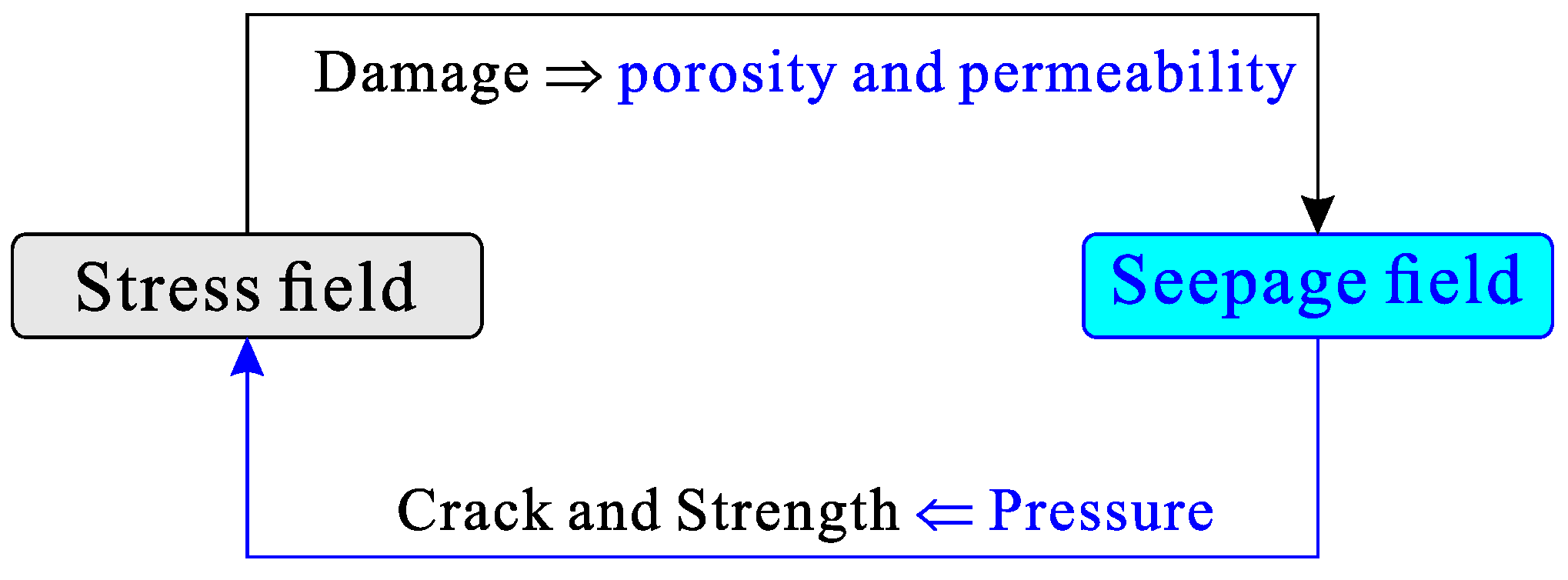
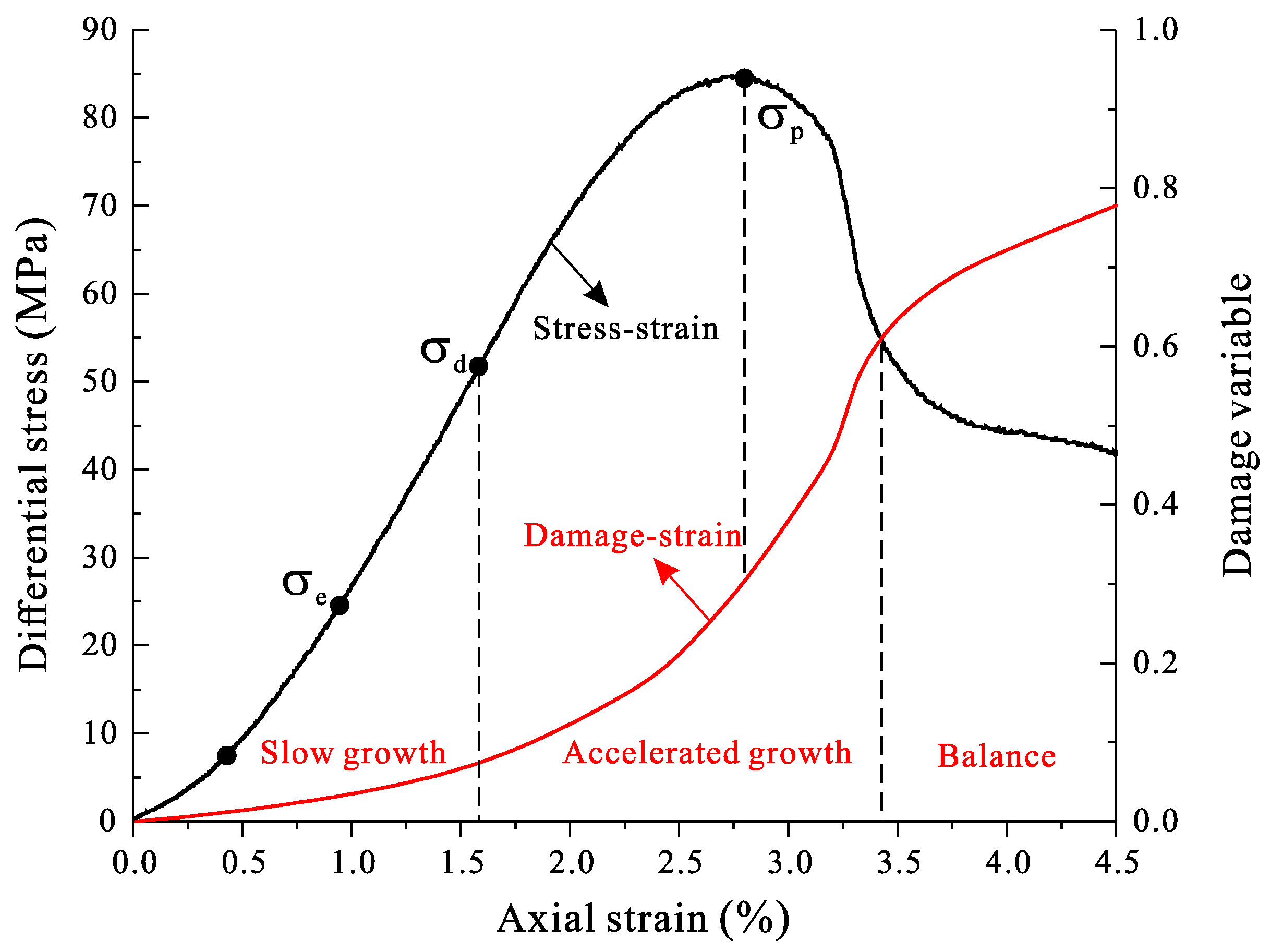
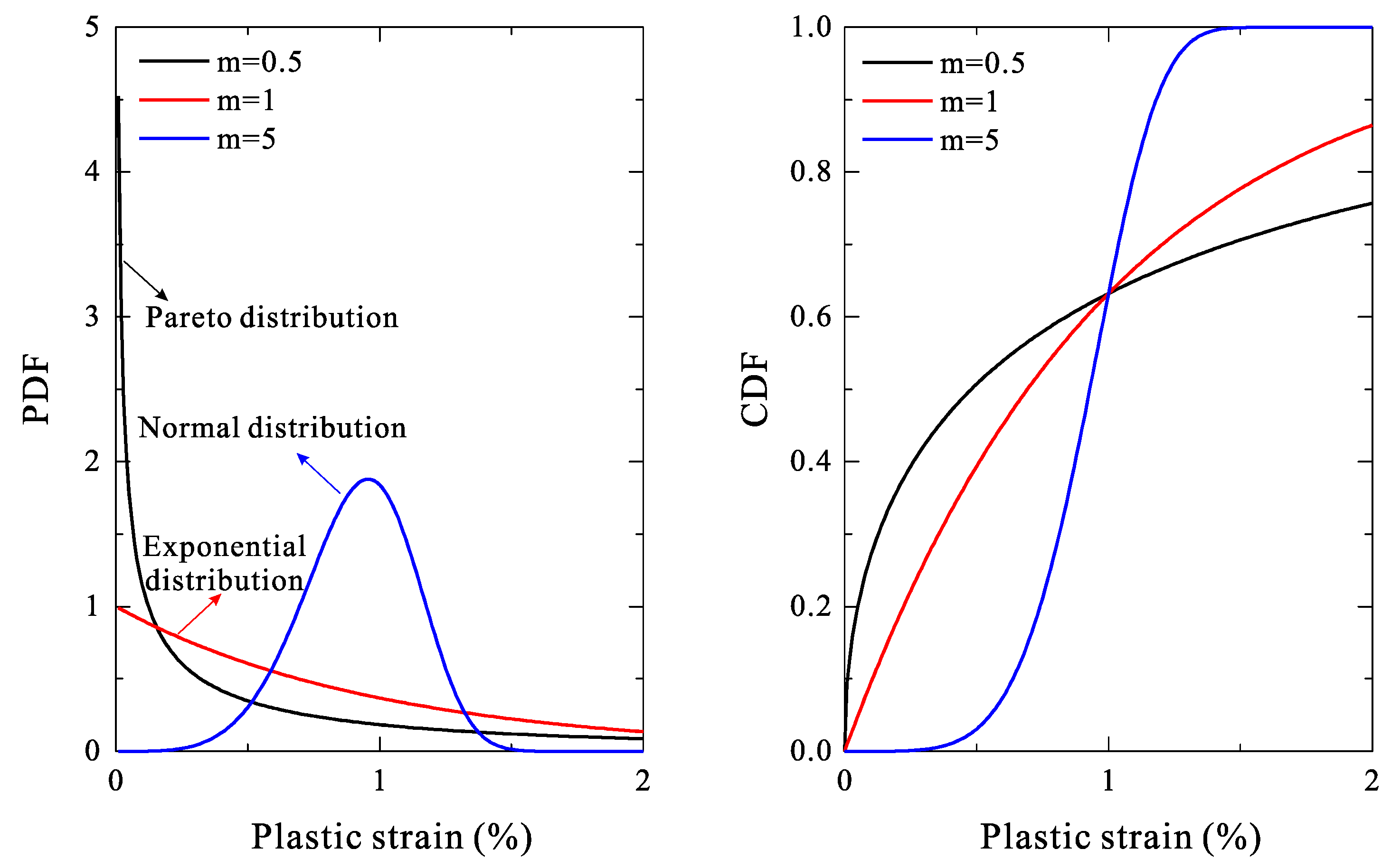
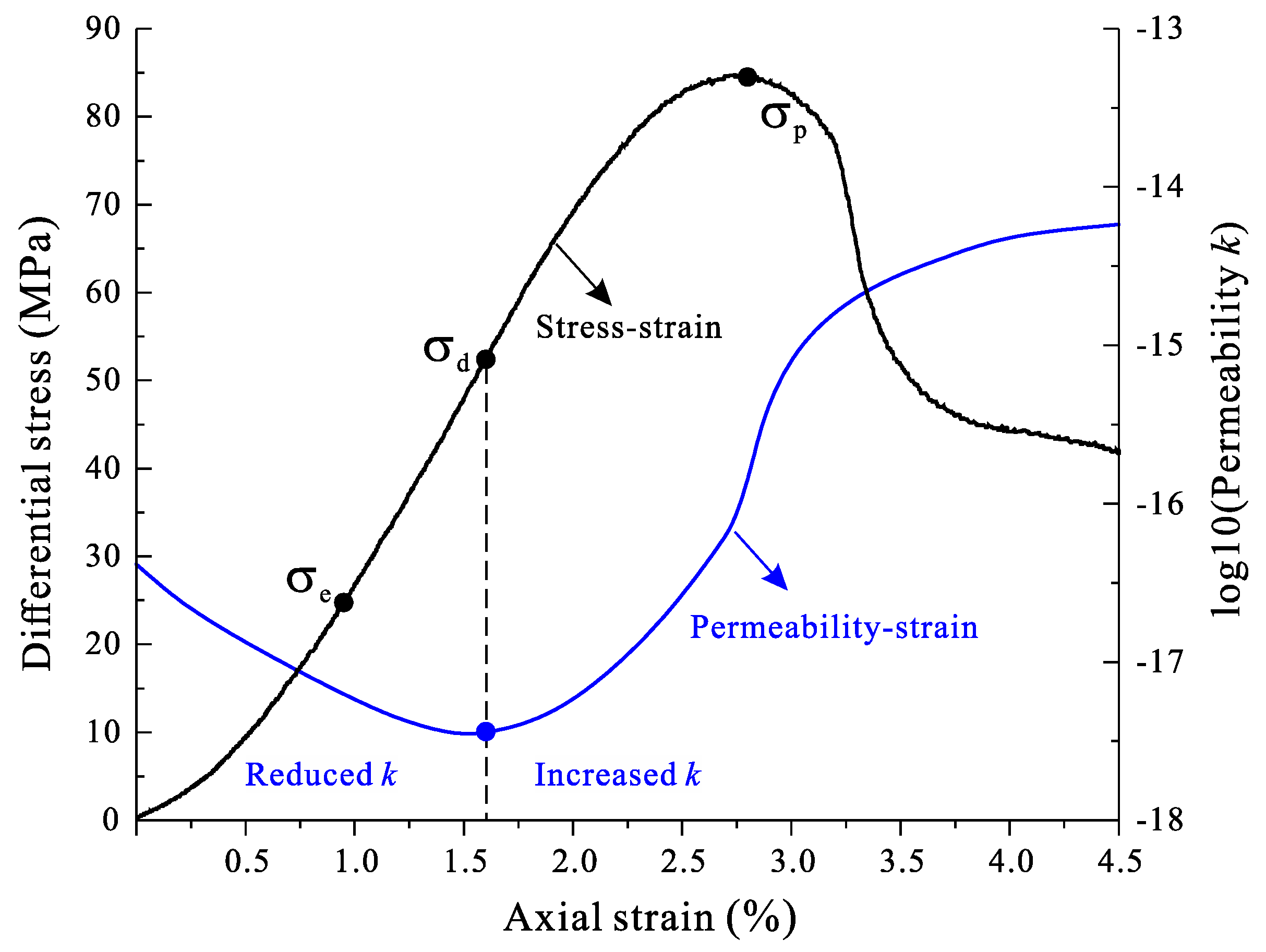
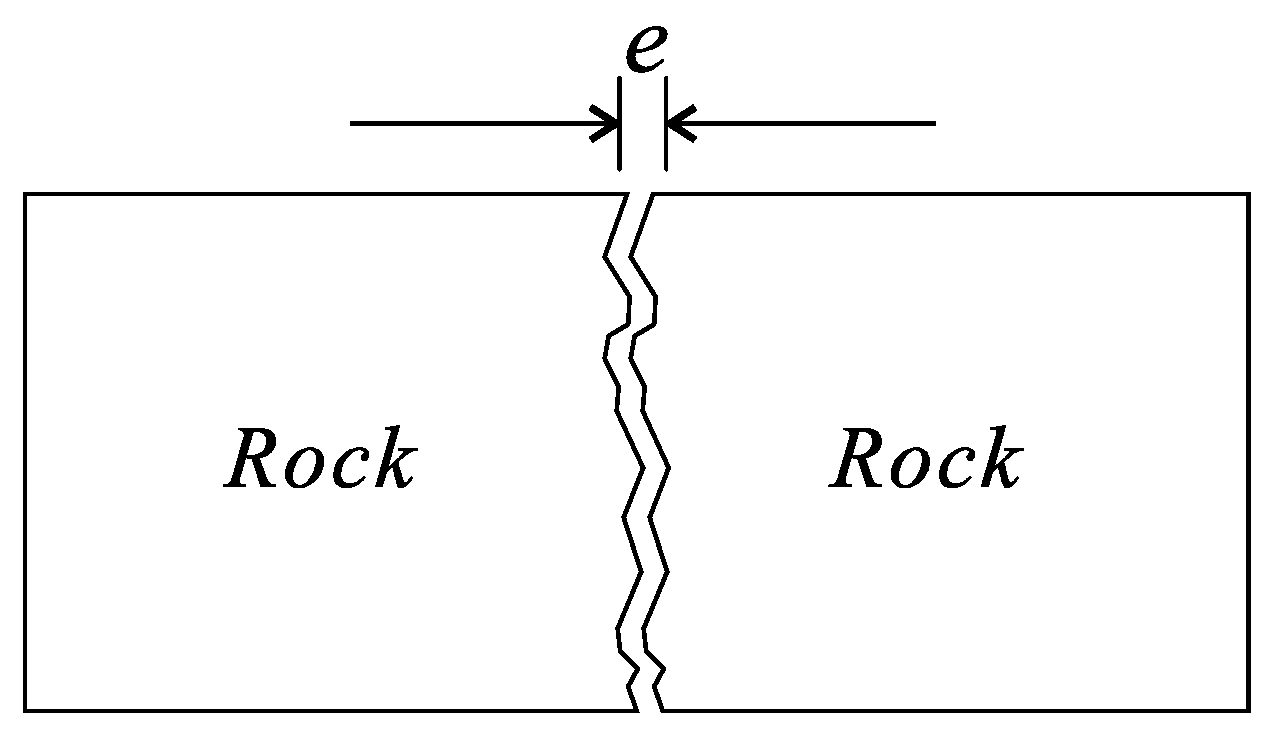
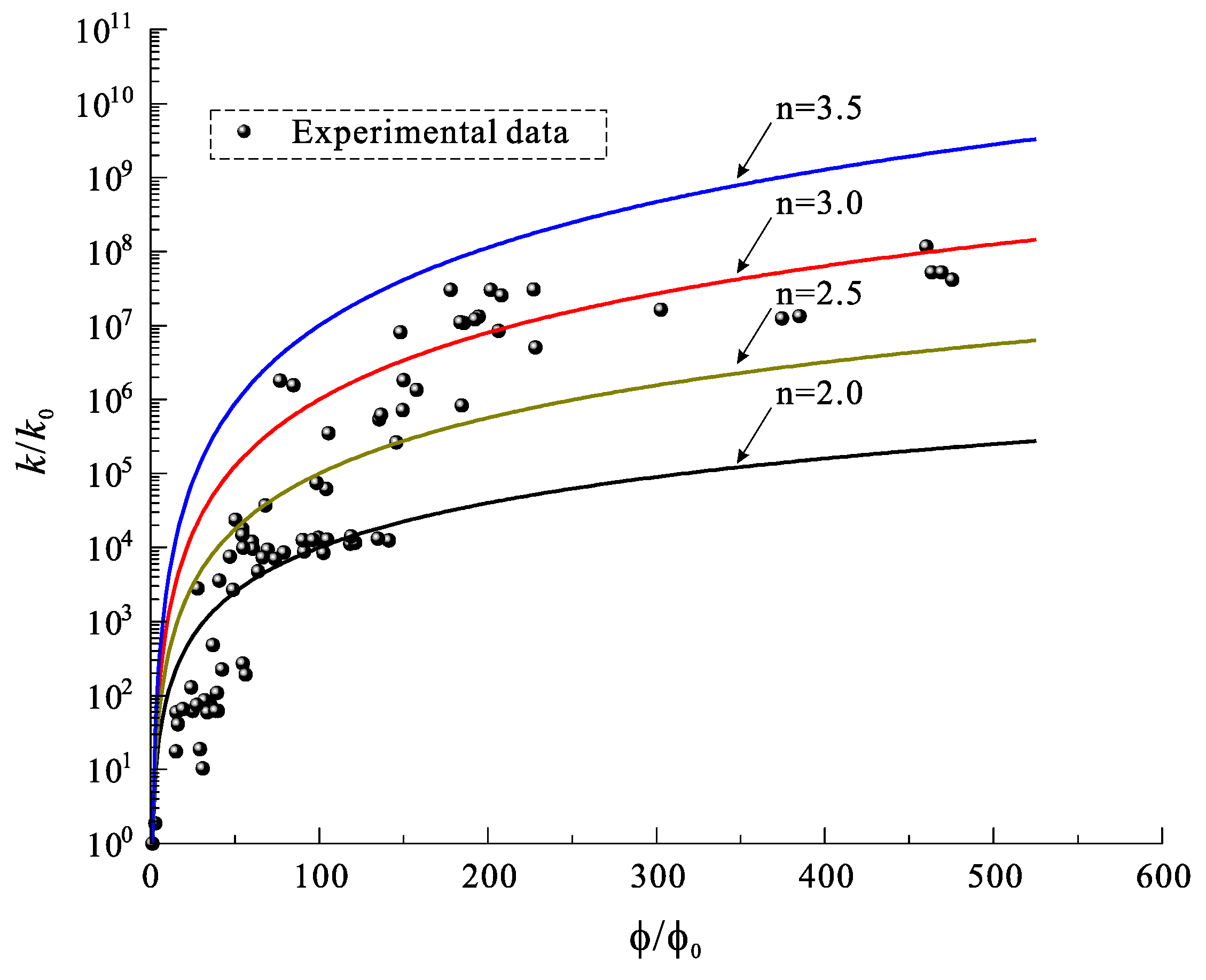
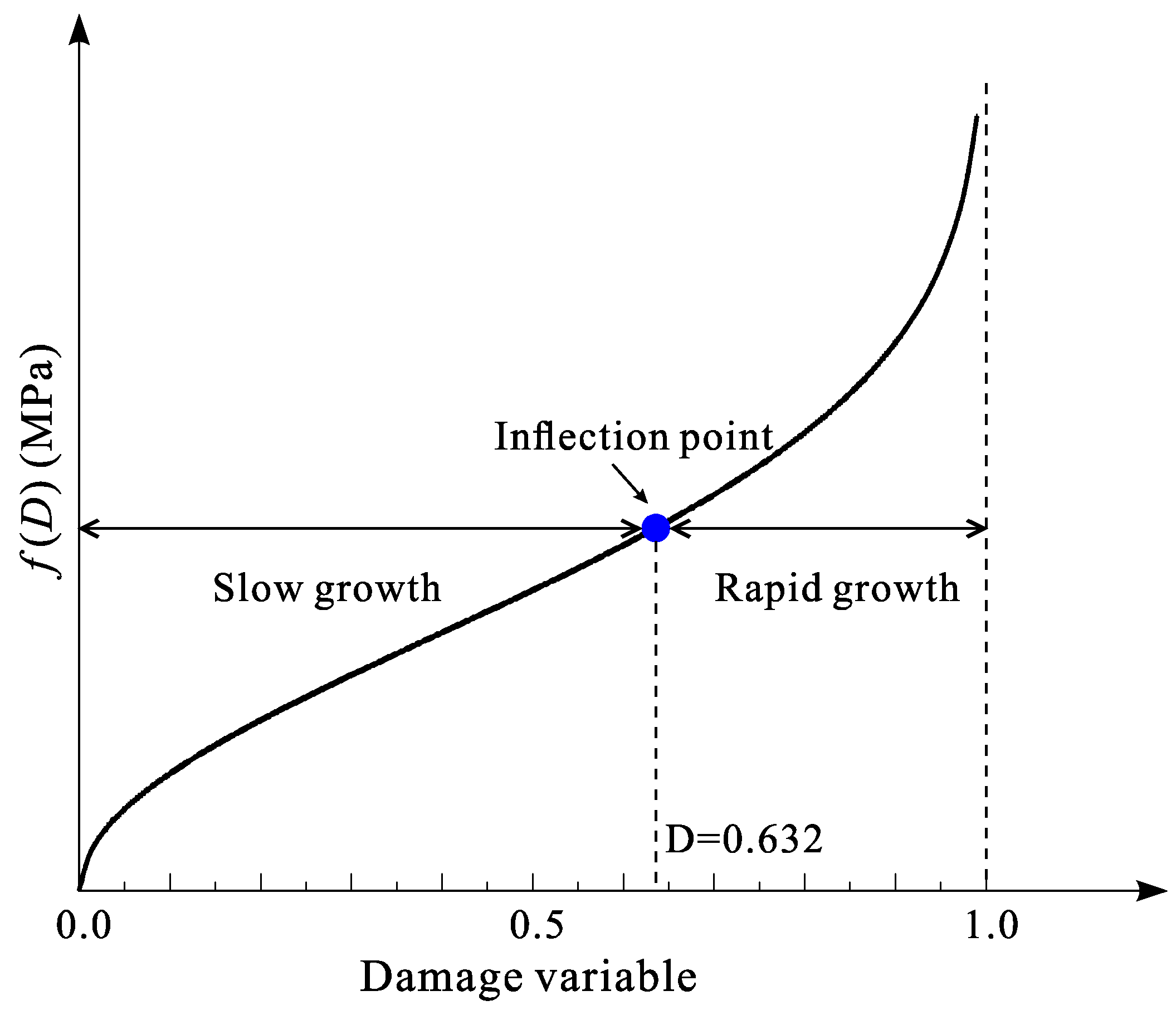

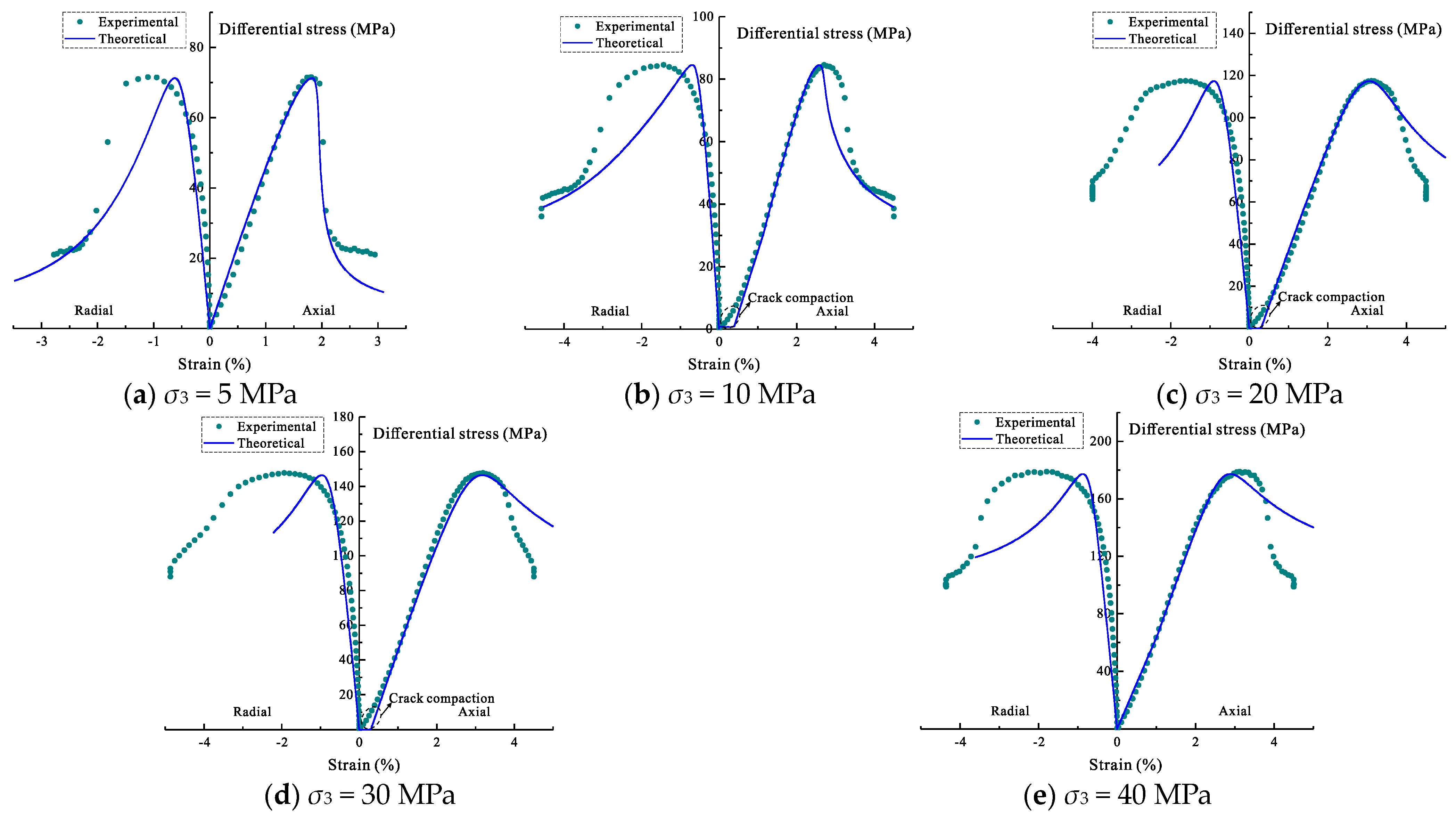

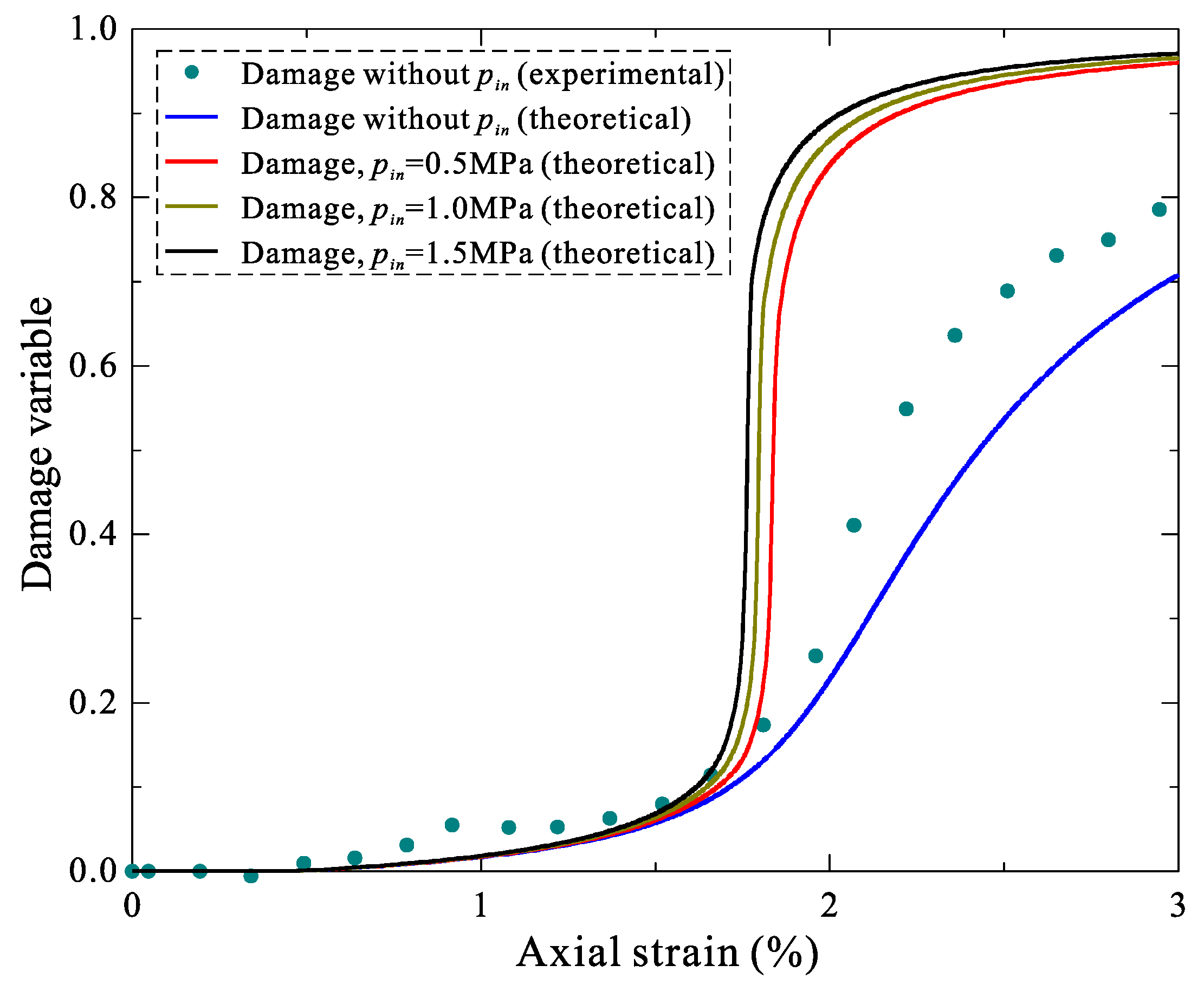

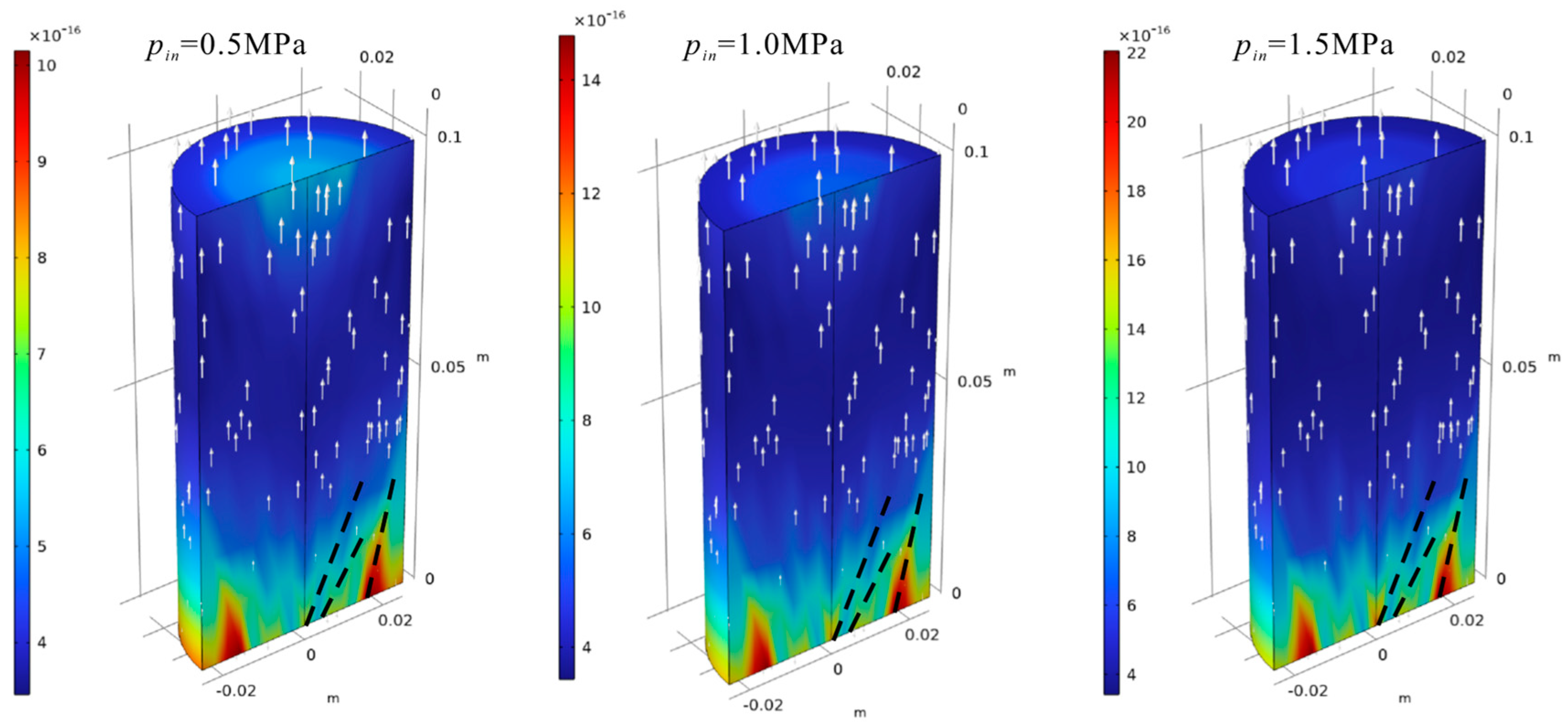

| Parameter | Value |
|---|---|
| Density of sandstone, ρ (kg/m3) | 2650.00 |
| Young’s modulus of sandstone, E (GPa) | 4.75 |
| Poisson’s ratio of sandstone, ν (1) | 0.28 |
| Cohesion of sandstone, c (MPa) | 10.88 |
| Angle of internal friction of sandstone, φ (°) | 31.56 |
| Initial porosity of sandstone, ϕ0 (%) | 7.76 |
| Initial permeability of sandstone, k0 (m2) | 3.99 × 10−16 |
| Dynamic viscosity of nitrogen, μ (Pa·s) | 1.76 × 10−5 |
Disclaimer/Publisher’s Note: The statements, opinions and data contained in all publications are solely those of the individual author(s) and contributor(s) and not of MDPI and/or the editor(s). MDPI and/or the editor(s) disclaim responsibility for any injury to people or property resulting from any ideas, methods, instructions or products referred to in the content. |
© 2024 by the authors. Licensee MDPI, Basel, Switzerland. This article is an open access article distributed under the terms and conditions of the Creative Commons Attribution (CC BY) license (https://creativecommons.org/licenses/by/4.0/).
Share and Cite
Rong, Y.; Sun, Y.; Chen, X.; Ding, H.; Xu, C. Analysis of Damage and Permeability Evolution of Sandstone under Compression Deformation. Appl. Sci. 2024, 14, 7368. https://doi.org/10.3390/app14167368
Rong Y, Sun Y, Chen X, Ding H, Xu C. Analysis of Damage and Permeability Evolution of Sandstone under Compression Deformation. Applied Sciences. 2024; 14(16):7368. https://doi.org/10.3390/app14167368
Chicago/Turabian StyleRong, Yao, Yang Sun, Xiangsheng Chen, Haibin Ding, and Changjie Xu. 2024. "Analysis of Damage and Permeability Evolution of Sandstone under Compression Deformation" Applied Sciences 14, no. 16: 7368. https://doi.org/10.3390/app14167368





